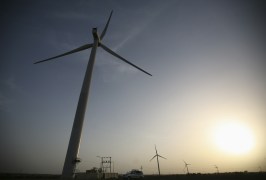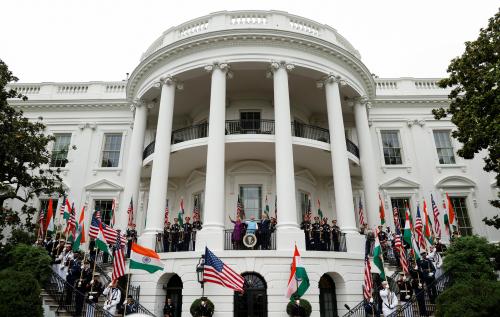Content from the Brookings Institution India Center is now archived. After seven years of an impactful partnership, as of September 11, 2020, Brookings India is now the Centre for Social and Economic Progress, an independent public policy institution based in India.
This article is a part of India 2024: Policy Priorities for the New Government, a compendium of policy briefs from scholars at Brookings India, edited by Dhruva Jaishankar and Zehra Kazmi, which identifies & addresses some of the most pressing challenges that India is likely to face in the next five years.
India faces a variety of challenges related to energy and the environment. Here are several initiatives that the next government could contemplate early on in its term.
Integrate Energy and Environmental Policy
The various ministries currently engaged with energy and the environment should be collapsed into one omnibus Ministry of Energy and Environment. This will perforate the current siloed approach to energy policy and enable the new government to view the sector through an integrated and holistic lens. It could more easily track and evaluate the systemic implications of changes in any one or more component variable. Secondly, an “Energy and Environment Security Act” should be passed at the earliest possible opportunity. The objective of such an act should be to bring energy and environment into the national narrative; to set out the road map for managing and mitigating the emergent challenge of balancing economic development and energy demands with the goal of environmental protection; and to mobilise public support for the policy and regulatory changes required to hasten the transition to a non-fossil fuel based energy system. Finally, energy data is scattered across various government departments. This hinders policy and investment. The new government should establish an integrated energy data centre, whose data should be regularly updated and made available to all players on commercial terms.
Decarbonise
Decarbonisation, demand management, and efficiency should be the watchwords of the new government’s energy policy. In this context, the focus should be on generating electricity from solar and wind, incentivising electric vehicles, curtailing diesel consumption in agriculture, enforcing standards and emission norms, redesigning buildings and factories to make them carbon neutral, and influencing behavioural change towards energy conservation. A multi-pronged thrust along these lines will weaken the current unhealthy relationship between economic growth, energy demand, and the environment.Additionally, the “clean energy fund” is currently funded through a cess on coal production. It is also managed by the Ministry of Finance. The fund should be augmented through the issuance of “Green Bonds” and perhaps a clean energy tax. Its administration should be handed over to those with domain expertise. The reason for the former is to intensify research and development on clean energy technologies (e.g. battery storage, carbon capture and sequestration, hydrogen, coal gasification, modular nuclear reactors, etc.) and to fund the transmission and distribution infrastructure required for absorbing the flow of clean energy. The reason is to safeguard the funds from sequestration into the Consolidated Fund, to create the conditions for incubating innovation, and to forge international R&D and technology partnerships.
Better Manage Resources
The levers of oil policy are today in the hands of autocratic leaders. This “personalisation” of oil politics would not have been an issue in the past when oil was traded mostly against long-term supply contracts. But today against the backdrop of an integrated, liquid, and fungible market characterised by short-term flexible deals, this is of relevance especially for import-dependent countries like India. The local actions of leaders now have global, supply-related ramifications. The new government should, therefore, look to develop a specialised cadre of “energy diplomats.” It should contemplate lateral entrants at mid- and senior levels of government with relevant domain and international expertise. It should unshackle the energy public sector units from intrusive bureaucratic oversight to enable their management to respond with agility to unexpected market developments. And it should establish strong personal relations with the leaders of oil exporting states. At crunch time, the latter could well be the peg on which India’s supply security hangs.
Close to home, India’s unattractive geology is the reason why the various bidding rounds for private sector investment in oil and gas exploration have not been a success. The new government should not stop this effort but it should consider three changes to the current contract terms. One, it should replace the current revenue sharing model with a production sharing model for new exploration. Two, it should link investment in the marginal and smaller discovered fields with access to the domestic retail market and remove the condition that only companies that have invested Rs. 2000 crores will be eligible for a marketing license. Three, it should contemplate bidding out Mumbai High and other major producing oil and gas fields to international players with proven enhanced oil recovery technologies. The current recovery rates of production from these fields are well below global average. Huge value add would accrue if our rates could be increased to global standards.
Coal represents another major resource. Coal India Limited (CIL) is a major producer of coal but faces huge legacy issues (labour unions, mafia, politics, and organisation) which constrain its ability to fully and efficiently harness the country’s indigenous coal reserves. These issues cannot be addressed without first redrawing the contours of India’s political economy. The new government cannot, understandably, tackle these issues early on in its tenure. It can, however, resurrect an earlier decision to allow private sector companies into commercial coal mining. The consequent pressure of competition will bear positively on the performance of CIL.
Finally, in India, natural gas has not realised its full potential. Four early initiatives should be contemplated. First, Gas Authority of India Limited (GAIL) should be unbundled into a monopoly gas pipeline company. It should be divested of its upstream (production and regasification) and downstream (petrochemicals) operations. These can be merged into one or more of the existing PSUs. Second, the “common access” principle must be fairly enforced. Every player, private or public, must have equal access to gas pipelines. Third, the price of gas should be determined on the basis of market principles. This principle should apply across the gas value chain, except pipeline tariffs which should be linked to return on capital. Fourth, the gas trading hub should be expeditiously established. Finally, concerns over contract sanctity and delays in the adjudication of disputes have been a major deterrent to investment in India’s energy sector. Special energy courts should be established to address these concerns.
The Brookings Institution is committed to quality, independence, and impact.
We are supported by a diverse array of funders. In line with our values and policies, each Brookings publication represents the sole views of its author(s).







Commentary
India 2024: A green India
May 17, 2019